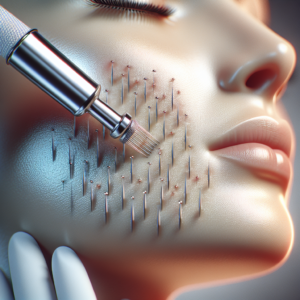Contents
Microneedling Side Effects: What to Expect and How to Avoid Them
Microneedling has become one of the most popular non-invasive skincare treatments for improving skin texture, reducing fine lines, and minimizing scars. But like any cosmetic procedure, it’s important to understand the potential side effects—especially if you’re new to the treatment.
While microneedling is generally considered safe, it can come with temporary reactions and risks if not performed properly or if aftercare is neglected. In this article, we’ll break down the most common microneedling side effects, why they happen, and how to prevent or minimize them so you can achieve the glowing results you’re looking for—safely.
Why Do Side Effects Happen After Microneedling?
Microneedling involves puncturing the skin with tiny needles to create controlled micro-injuries. This stimulates the body’s natural wound-healing response, increasing collagen and elastin production. Because the skin is being intentionally injured, it’s normal to experience mild side effects as part of the healing process.
However, the severity and duration of these side effects can vary depending on your skin type, the depth of the needles used, whether the procedure was done professionally or at home, and how well you care for your skin afterward.
Common Microneedling Side Effects
1. Redness and Irritation
This is the most common side effect. Right after treatment, your skin may look and feel like it’s sunburned—red, warm, and slightly sensitive to the touch. This usually lasts 24 to 72 hours, depending on the intensity of the session.
2. Swelling
Minor swelling can occur as part of the body’s inflammatory response. It’s generally mild and subsides within a couple of days.
3. Dryness and Peeling
As your skin begins to heal, you may experience dryness or flaking. This is a sign that dead skin cells are shedding and making way for new, healthier skin.
4. Bruising
Bruising is less common but can happen, especially around sensitive areas like under the eyes. This is more likely if you bruise easily or take blood-thinning medications.
5. Increased Sensitivity
Post-treatment, your skin may be more sensitive to skincare products, sunlight, and environmental factors. You might feel a slight burning or tingling sensation when applying products for a few days.
6. Temporary Breakouts
Microneedling can occasionally trigger breakouts, particularly if you are acne-prone. This could be due to bacteria being introduced into the skin or a temporary reaction as your skin purges impurities.
7. Hyperpigmentation
For some individuals, especially those with medium to dark skin tones, microneedling may cause temporary darkening of the skin (post-inflammatory hyperpigmentation). This is often a result of improper aftercare or sun exposure too soon after treatment.
Rare but Serious Side Effects
Though uncommon, more serious side effects can occur, particularly if the procedure is done incorrectly or with unsterile tools:
- Infection: If bacteria enter the micro-wounds, infections can develop. This is more likely when using non-sterile equipment or poor hygiene post-treatment.
- Scarring: Overuse, too much pressure, or microneedling over active acne can cause scarring.
- Allergic Reactions: Using irritating products like retinol, AHAs, or scented skincare too soon after microneedling can lead to rashes or allergic reactions.
To avoid these risks, always work with a licensed, experienced professional and follow proper aftercare instructions.
How to Avoid or Minimize Side Effects
1. Choose a Qualified Professional
Professional microneedling devices allow for adjustable needle depths and sterile, single-use cartridges. Going to a licensed dermatologist or esthetician ensures the procedure is performed in a clean, controlled environment.
2. Avoid Active Acne and Skin Conditions
Microneedling should not be done over areas with active breakouts, eczema, or rosacea flares. Doing so can spread bacteria and worsen inflammation.
3. Follow Pre-Treatment Instructions
Before your session, avoid retinoids, exfoliants, and alcohol-based products for at least 3–5 days. Don’t use NSAIDs like ibuprofen, which can reduce the inflammation needed for collagen production.
4. Prioritize Aftercare
After microneedling, your skin is in a vulnerable state. Proper aftercare is crucial to healing and minimizing irritation:
- Keep your skin clean and avoid touching your face with dirty hands.
- Use only gentle, hydrating products recommended by your provider.
- Avoid makeup, retinoids, and acids for 3–5 days.
- Apply a mineral-based sunscreen daily—even indoors.
5. Stay Out of the Sun
UV exposure can worsen redness and trigger hyperpigmentation. Avoid direct sunlight for at least one week and wear SPF 30+ religiously.
6. Avoid Sweating and Swimming
Skip the gym, saunas, and swimming pools for 48 hours. Sweat and water from pools or the ocean can introduce bacteria into your healing skin.
7. Space Out Your Sessions
Microneedling isn’t a weekly treatment. Space sessions 4–6 weeks apart to allow proper healing and collagen regeneration. Overdoing it can lead to long-term irritation or scarring.
Who Should Avoid Microneedling?
Microneedling isn’t suitable for everyone. You should avoid it if you have:
- Active acne or cysts
- Severe rosacea or eczema
- A history of keloid or hypertrophic scarring
- Open wounds or active skin infections
- Blood clotting disorders
- Recently used Accutane (within 6 months)
If you’re unsure whether microneedling is safe for you, consult a board-certified dermatologist before booking a session.
When to See a Doctor
If you notice any of the following after microneedling, contact your healthcare provider immediately:
- Signs of infection (increased redness, pus, warmth, or swelling)
- Severe or prolonged bruising
- Blistering or bleeding
- Persistent pain or burning sensation
It’s always better to play it safe, especially when it comes to your skin’s health.
Final Thoughts
Microneedling is a powerful, proven treatment for improving skin tone, texture, and scars—but like any skin procedure, it’s not completely without side effects. The key to safe and successful results lies in proper technique, hygiene, and aftercare.
By knowing what to expect and how to prepare, you can minimize unwanted side effects and enjoy the benefits of fresher, smoother, and healthier skin. Always consult a licensed professional before beginning your microneedling journey, and take the time to give your skin the care it deserves afterward.
Remember: great skin is a journey, not a one-time fix. With the right approach, microneedling can be a valuable step on the path to your best skin ever.


